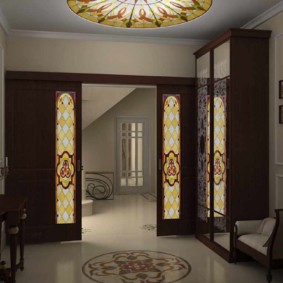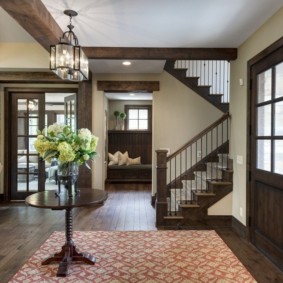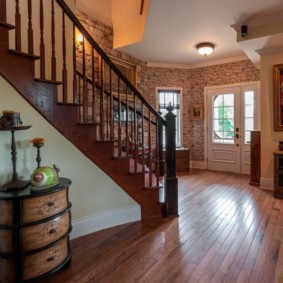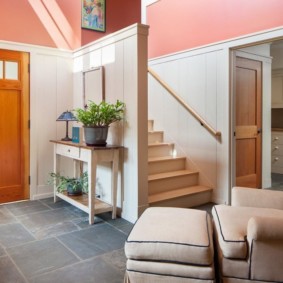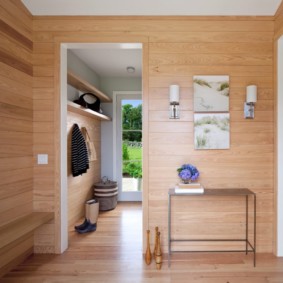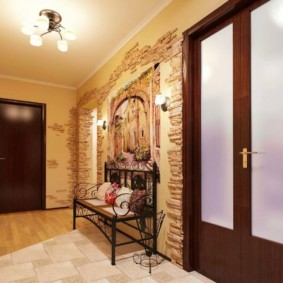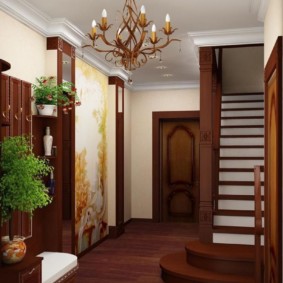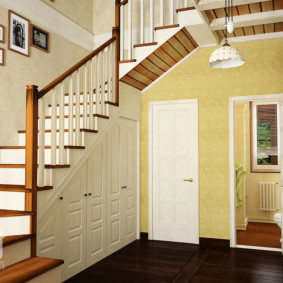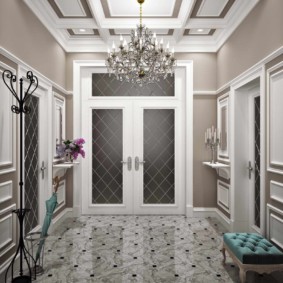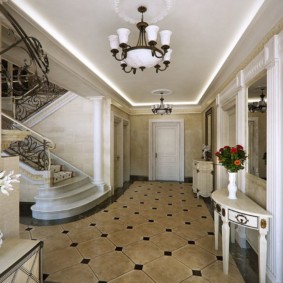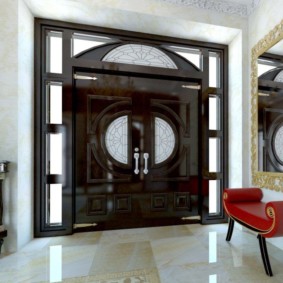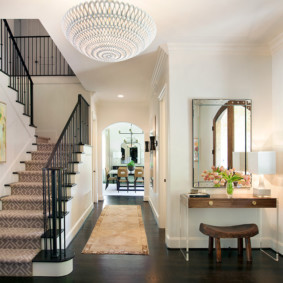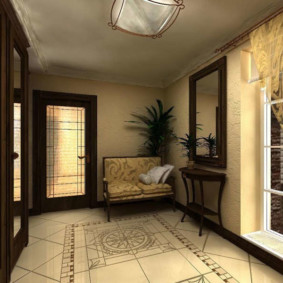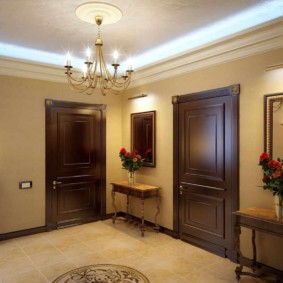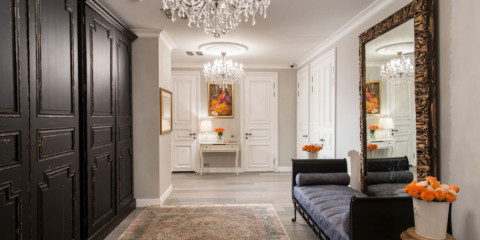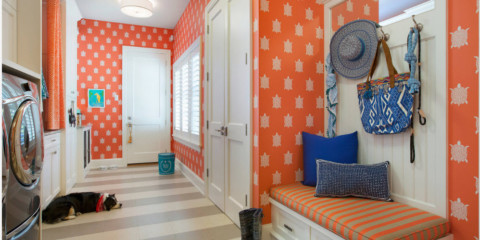 Hallway
Dressing room design under the stairs - ideas and options
Hallway
Dressing room design under the stairs - ideas and options
As a theater begins with a coat rack, so a house begins with a hallway. And the impression of the interior is formed at a glance at the design of the corridor. In a private house there are more opportunities for translating interesting modern ideas.

The entrance hall is the first room that those who enter the house see.
Popular styles for decorating the hallway
Content
The current trends in the decoration of the hallway are very diverse, especially since the range of available finishing materials and interior items is larger than ever. However, there are undeniable “leaders” in frequency of use.

It is the entrance hall that should create a feeling of comfort and tranquility.
Art Deco
An interesting direction of design. Classics and ethno “in one bottle”. A distinctive design feature in this style is the prevailing monophonic gamut with bright accents. Art Deco “prefers” expensive materials for decoration and is not indifferent to shine, geometry in ornament and stucco molding is welcomed.

Merging in one room trends of modern fashion, decorated with various things and elements of antiquity.
Furniture for this style is necessarily selected wooden, with expensive carvings. An integral attribute of the hallway is a large mirror in a carved frame.

For decor, ethnic figurines, lamps with wrought iron elements, as well as all kinds of paintings, vases, and other ethnic souvenirs are used.
Country
This style creates extraordinary cozy and pleasant interiors. According to many, country is the best option for a corridor in a country house. Preference is given to natural finishes: stone, wood, fabric. The ceiling is formed by a beam (this element does not have to be a supporting structure, decorative imitation is suitable). The floor is covered with natural wood with a pronounced textured pattern.

This style corresponds to the execution of all interior elements from wood.
The furniture used is rude handmade. Large dressers, voluminous cabinets and tables, as well as deliberately coarse hangers (ideally old) fit perfectly into such an interior.
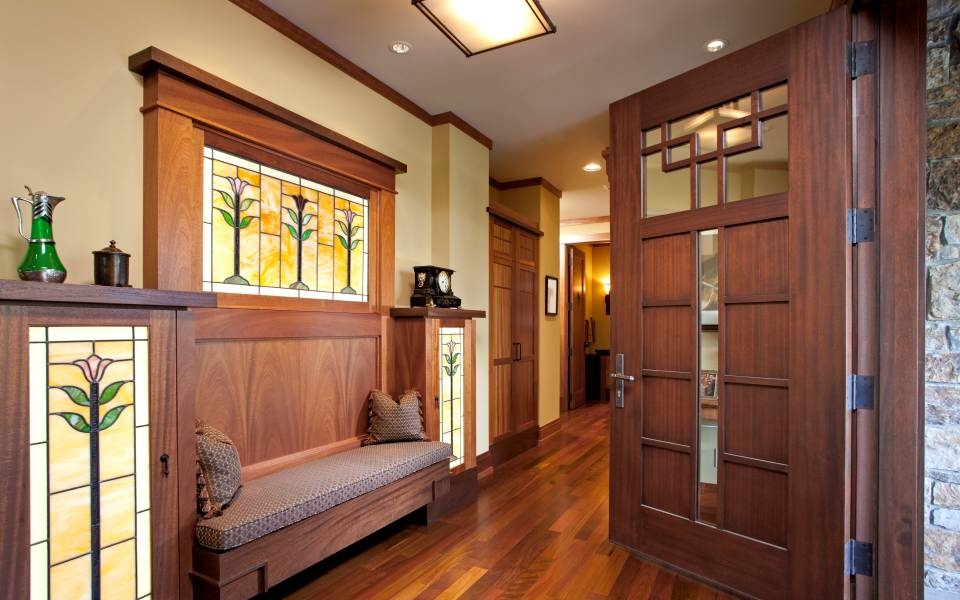
The main features of the style are cosiness, simplicity and comfort.
For decor use woven paths, wicker baskets, wrought iron lamps and paintings with rural landscapes.
Modern
To a certain extent, the words “modern” and “freedom” are synonyms. This style is characterized by the absence of strict lines and angles. Asymmetry and a natural color palette are welcome. If you select a pattern, then preference is given to floral ornaments.
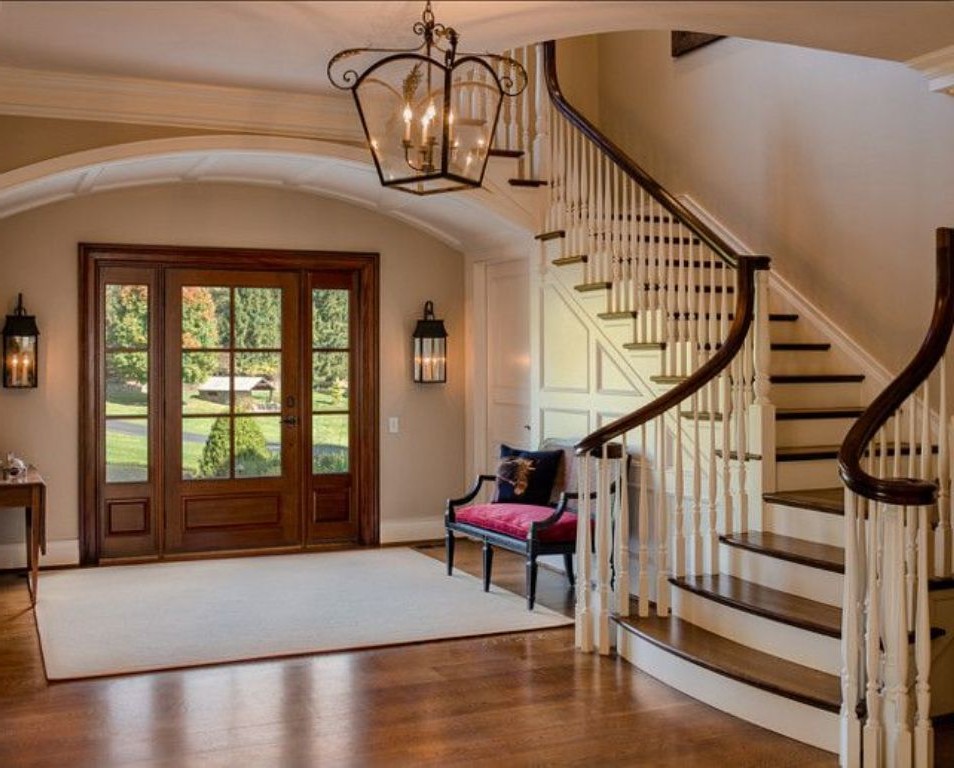
Walls and furniture must certainly be in harmony with each other.
The emphasis in the Art Nouveau interior is on furniture of simple forms. The main thing is convenience. Facades are moderately complemented by stained-glass windows with plant drawings.

Art Nouveau is replete with a lot of glass and metal.
Art Nouveau does not welcome the abundance of decorative “unnecessary things,” but additional light sources will have to be taken care of.
Japanese style
Oriental design is gaining popularity. Such an interior is distinguished by simplicity and functionality, complemented by appropriate decorative elements.

The color scheme is restrained, natural materials prevail in the decoration.
English style
Aristocracy in the details. This is what is called an ageless classic. For wall decoration, decorative plaster is chosen, and parquet for the floor.As decorative elements - paintings on the walls, figurines, a carpet with a discreet pattern on the floor, and elegant lamps to match the furniture.

The furniture is concise, but with an exquisite finish.
Chalet
Where else to embody the style of a chalet, if not in a country cottage! Expensive natural finishing materials with aging effect - a distinctive feature of this design. The interior requires serious financial costs: stone, wood, decorative plaster, special furniture. Furniture items are characterized by upholstery made of fabric, leather or fur. Wicker interior items are allowed.

This is a suitable option for a hallway in a wooden house.
Skins, wrought iron candlesticks and paintings depicting ancient castles will help to complement the atmosphere of a hunting lodge.
Take into account the layout
The embodiment of any design depends on the source data. In other words, it all depends on the layout and size of your hallway. If you are building a house from scratch, then plan ahead what functions each room will perform.

A pre-designed design concept for the whole house would be ideal.
- For example, if the hall is not clearly separated from the rest of the rooms, consider zoning the space.
- Furniture is selected depending on the size of the hall. Modern models will make even a small space functional. And the design itself is planned depending on the tasks that the hall will have to "perform" later.
Therefore, if your corridor is not large, it makes sense to abandon the interior doors, and connect the premises (for example, the hallway and the kitchen) through the arch.

Most often, when choosing a hall design, you need to start from the budget, from your own ideas and from the future functionality of the room.
And yet, regardless of the size of the hall and interior design, there are mandatory accessories for the entrance: a wardrobe, a shelf for shoes, a pouf (bench) and a mirror. The spacious hall will also contain shelves and small sofas, but the small hallway will have to be “content” with a limited set of small furniture.

You can search for any common features with all rooms or perform work in a completely different style, which goes against the general features of the style of the house.
We choose materials for decoration
It is a long-known fact: the higher quality materials are chosen for decoration, the more creative and durable the repair is. Therefore, it costs more time and attention to choose the appropriate finishing materials.

The design of the corridor often depends on its shape.
Wall decoration
Surely, you are familiar with a situation where on the walls of the hallway there are completely non-artistic traces of moisture or dirt after changing clothes. Alas, everyone has come across this. But the situation is not hopeless. Choose a wall covering that can be easily washed or, in extreme cases, on which such marks are not very noticeable.

If the room is not separated from the main area by doors, then it is necessary to carry out zoning of the space.
- MDF or PVC plastic. A common solution, but for someone, this finish is associated with public institutions. But do not rush to conclusions. The modern assortment guarantees the selection of interesting colors of this material, so that neither you nor your many guests will even have a thought about the similarity with the official wall decoration. Well, the practicality of such panels cannot be overestimated: they are durable, wash well and create a decent appearance of the room. Another advantage of plastic is its affordable price (compared to natural materials), and as a bonus, it also has excellent sound insulation.
- Laminate. With its help, they finish not only the floor, but also the walls. The option is not cheap, but it also looks decent. There are models that imitate almost any wooden coating: oak, beech, mahogany or black rosewood.The coating is very resistant to mechanical stress and durable. The only thing to worry about is the level of humidity, the laminate does not tolerate dampness and temperature jumps.
- 3D panels. A relatively new design decision. They have become a worthy alternative to decorative plaster. They are mounted on special glue and then coated with acrylic varnish. Everyone who crosses the threshold of your home will appreciate this option. A long service life and ease of maintenance are additional arguments in favor of such a finish.
- Wallpaper. Ancient as the world option for wall decoration in any room. It is worth noting that modern wallpapers are distinguished by a dense top layer, they can be washed. Well, a huge assortment of color options guarantees an interesting and practical design of the hall.
- Ceramic tile. Probably, a material more resistant to all kinds of influences has not yet been invented. It is no coincidence that with such an abundance of new and unusual finishing options, it is the tile that remains at the peak of popularity for decorating the hallway in the house. Among other things, modern tiles easily "imitate" the surface of natural wood. And this is another argument in her favor.
- Plaster. This way of decorating the hall can be called so: cheap and cheerful. Of course, this is not the most budget option, but the combination of price and quality is considered one of the most popular. Moreover, modern decorative plaster has nothing to do with its “progenitor” from the last century, from which there were endless white spots on clothes and shoes.
- Decorative stone is another solution for a hall in a private house. Besides, in fact, the decoration function, it easily copes with zoning of space and creates a unique atmosphere.
- Frescoes. Not the most common option only because of cost and unfamiliarity with the consumer. But the right choice of pattern will visually increase the space and make the room of irregular shape more symmetrical.
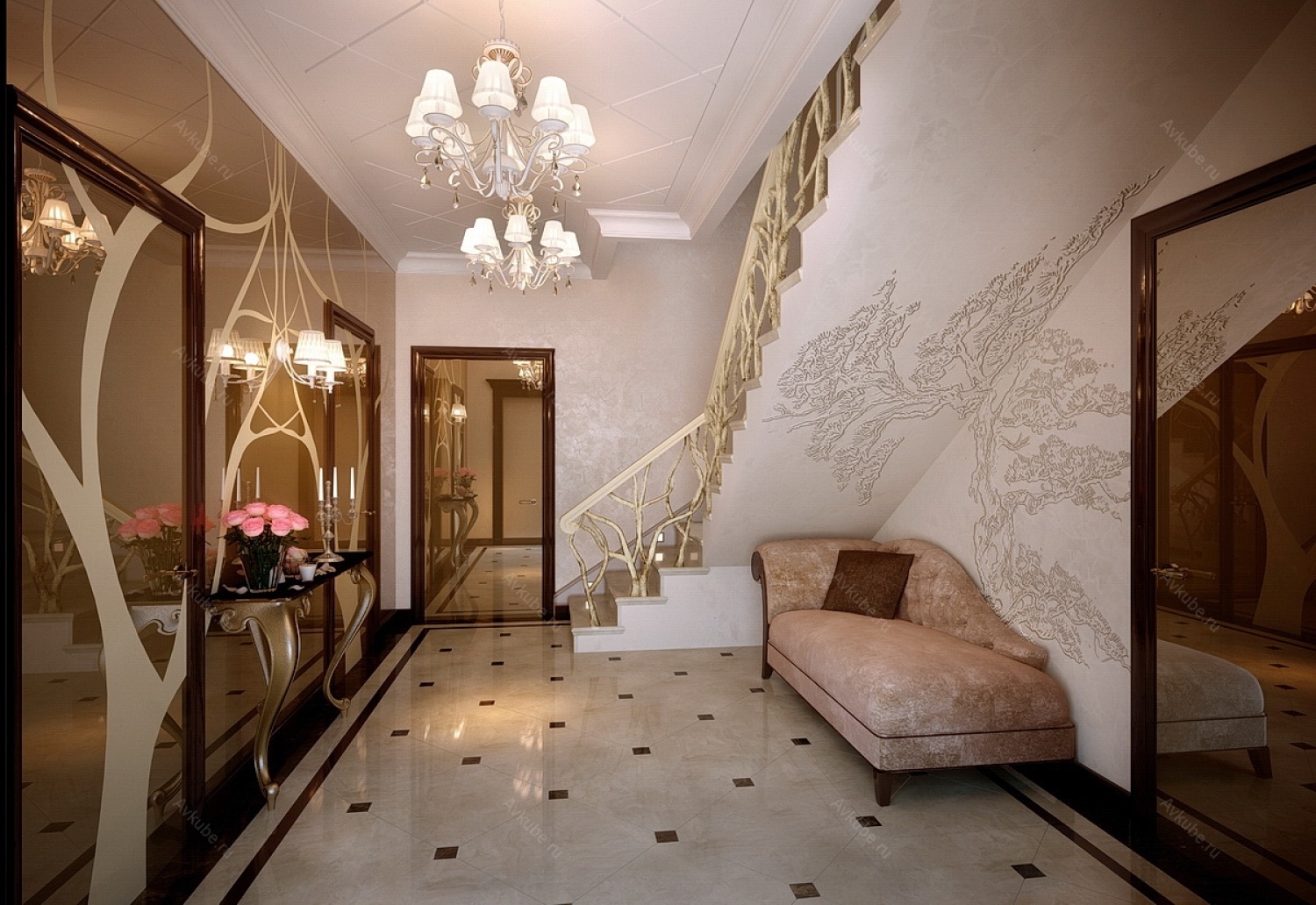
When choosing furniture, you must consider the size of the corridor.
When choosing a decoration material for walls, remember that each of them has both advantages and disadvantages. Therefore, only you can decide.

When choosing hallway elements, it is necessary to take into account not only the design, but also the functionality of each part of the hallway.
Floor
The floor in a modern house is designed to be not only a beautiful addition to the overall design solution, but also a functional element. For example, underfloor heating has long ceased to be something unbelievable. In addition, no one is surprised at the long-term service life of the floor covering. So, what to choose for flooring.

If there is free space, you can use a certain number of decor elements.
- Linoleum. A traditional solution with a long history. This material is easy to “lay down”; if necessary, it is easy to change. Yes, and it costs quite acceptable. Linoleum of good quality from a well-known manufacturer will serve you faithfully for fifty years. Therefore, the demand for material is justified.
- Ceramic tile. This is a suitable option for floor heating. Abrasion resistance, long service life and ease of maintenance are advantages that cannot be overestimated. The ceramic tile imitating parquet looks spectacular. If you are looking for an interesting solution for the floor in the hallway - perhaps this is your option.
- Natural stone. This is one of the most expensive options, but it's worth it. First of all, the difficulty lies in preparing for installation. This gender will serve not only you, but also your children and grandchildren. He will never go out of style. And so that the surface does not lose its original appearance - give preference to matte samples.
- Parquet. In this case, everything is clear without words: beautiful, expensive and convenient. The only caveat: parquet is not the most practical solution for a hallway, especially in conditions of increased use.
- Carpet.One of the most unsuccessful options for the hallway. The pile is constantly contaminated, the appearance is lost after a week of operation, and it is almost impossible to put such a coating in order.

It is necessary to responsibly approach such a process as independent finishing of the corridor.
Ceiling
The first thing that comes to mind is painting or whitewashing the ceiling in the lobby. And, I must admit, these options are not the worst. The only condition: such a solution is suitable only for a perfectly flat surface. If your ceiling does not differ in mirror smoothness - then it is better not to risk it. Another argument in favor of painting is low ceilings, when any additional centimeter of material will “steal” the already modest dimensions.

Calm shades characterize comfort and peace.
More recently, a universal “favorite” was polystyrene tile. The material was highly appreciated for its ease of installation and additional thermal insulation. Today, such tiles are gradually disappearing into oblivion, its appearance is already very cheap. In addition, the tile easily ignites, which is also an argument to refuse to use it.
A popular and practical option is multi-level modular ceilings. With their help, you can visually "correct" the irregular shape of the room, and they allow you to effectively position the lamps. And stretch ceilings will hide surface imperfections and save the room in the event of a roof leak.

It is best to choose a stylish hallway concept, properly trim and make this room brighter.
An unusual solution for decorating the ceiling is to make its central part mirrored. But you will have to wash such a ceiling often, since any speck will attract attention and spoil the overall impression of an interesting design.
Hall lighting
The design of the hallway in a private house will sparkle with renewed vigor in the right light. Since there is usually no natural lighting in the corridor, the location of the lamps and their brightness are planned in detail.
Important! Avoid too bright lighting that cuts your eyes.
Do not hang the chandelier too low, because it will be constantly touched by dressing and undressing guests.

Give preference to built-in lamps or wall (for example, stylish sconces).
Switches are best located at the beginning of the corridor, and at the end. If this option does not suit you, try to mount the motion sensors so that the light comes on (turned off) exactly when you cross the threshold of the hallway (it does not matter if you enter or leave the room). This is also a great opportunity to save.
Even in a private house, you can save on the use of electricity if you install glass doors, or doors with glass inserts. Then the light penetrating from the neighboring rooms will make the stay in the corridor more comfortable and will allow you to easily get to the switch.
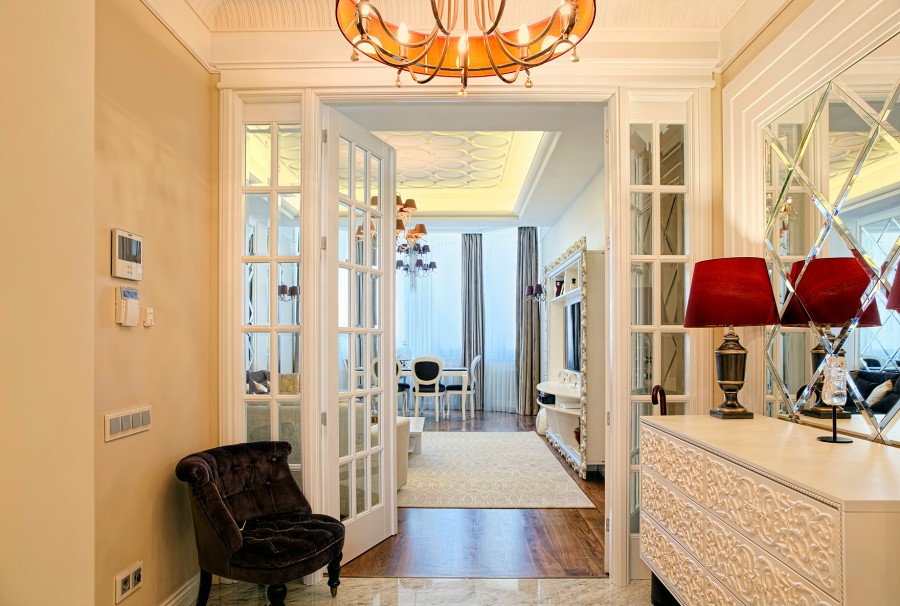
Properly located light sources will adjust the space.
So, for example, in long hallways, spotlights are recommended to be installed at an equal distance. And if the hall has very high ceilings, then it is better to mount the lamps on the walls, rather than on the ceiling.
As you can see, the corridor will become comfortable and stylish if you are not afraid of unusual decisions and keep up to date using modern finishing materials. Detailed planning and consultation of professional designers will help to avoid mistakes.

Thus, your hall will certainly become the subject of admiration for relatives and friends.
VIDEO: Design of an entrance hall with stairs to the second floor.




